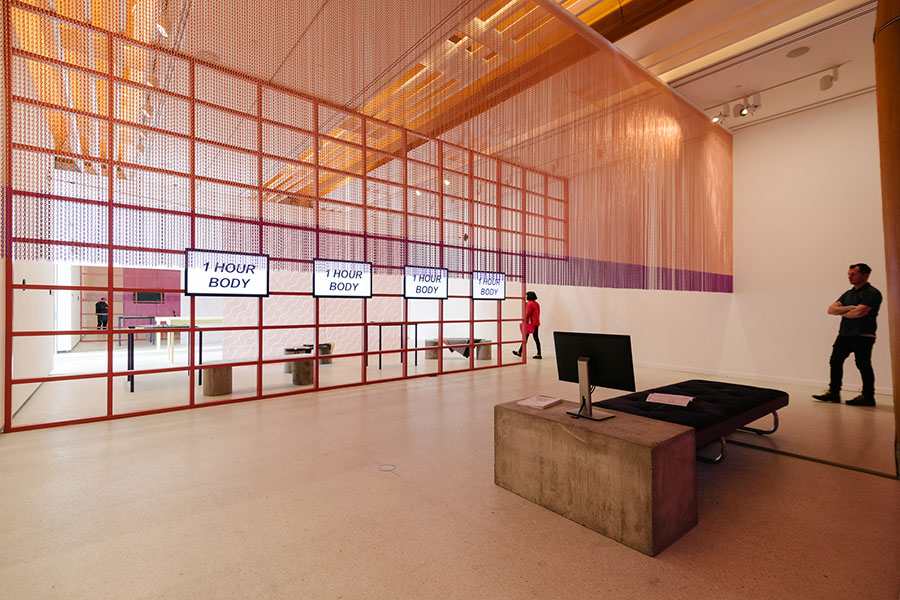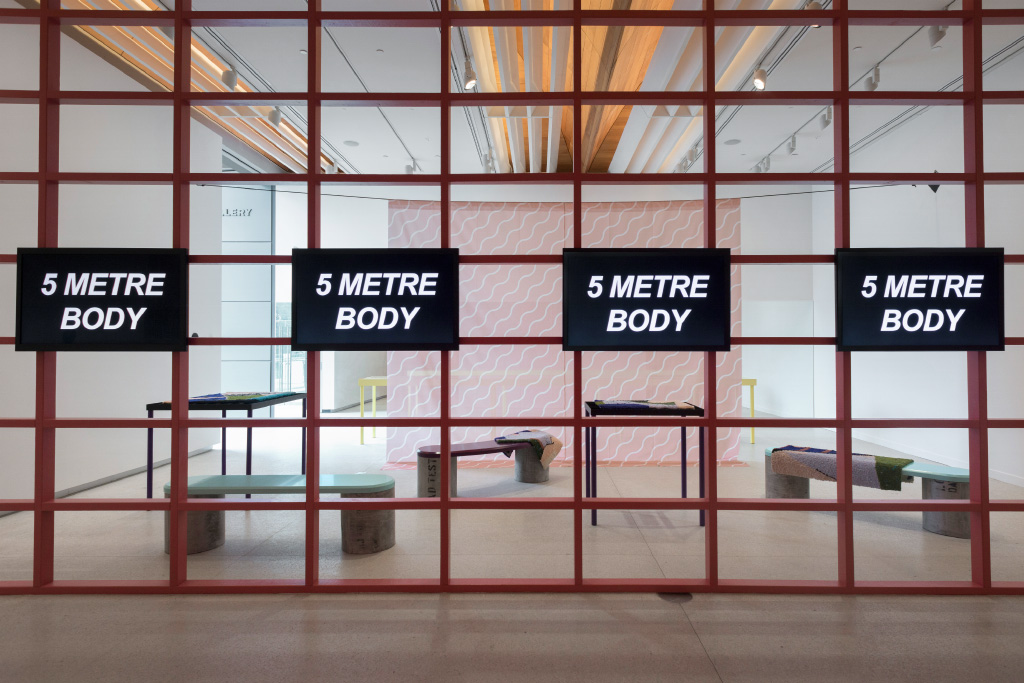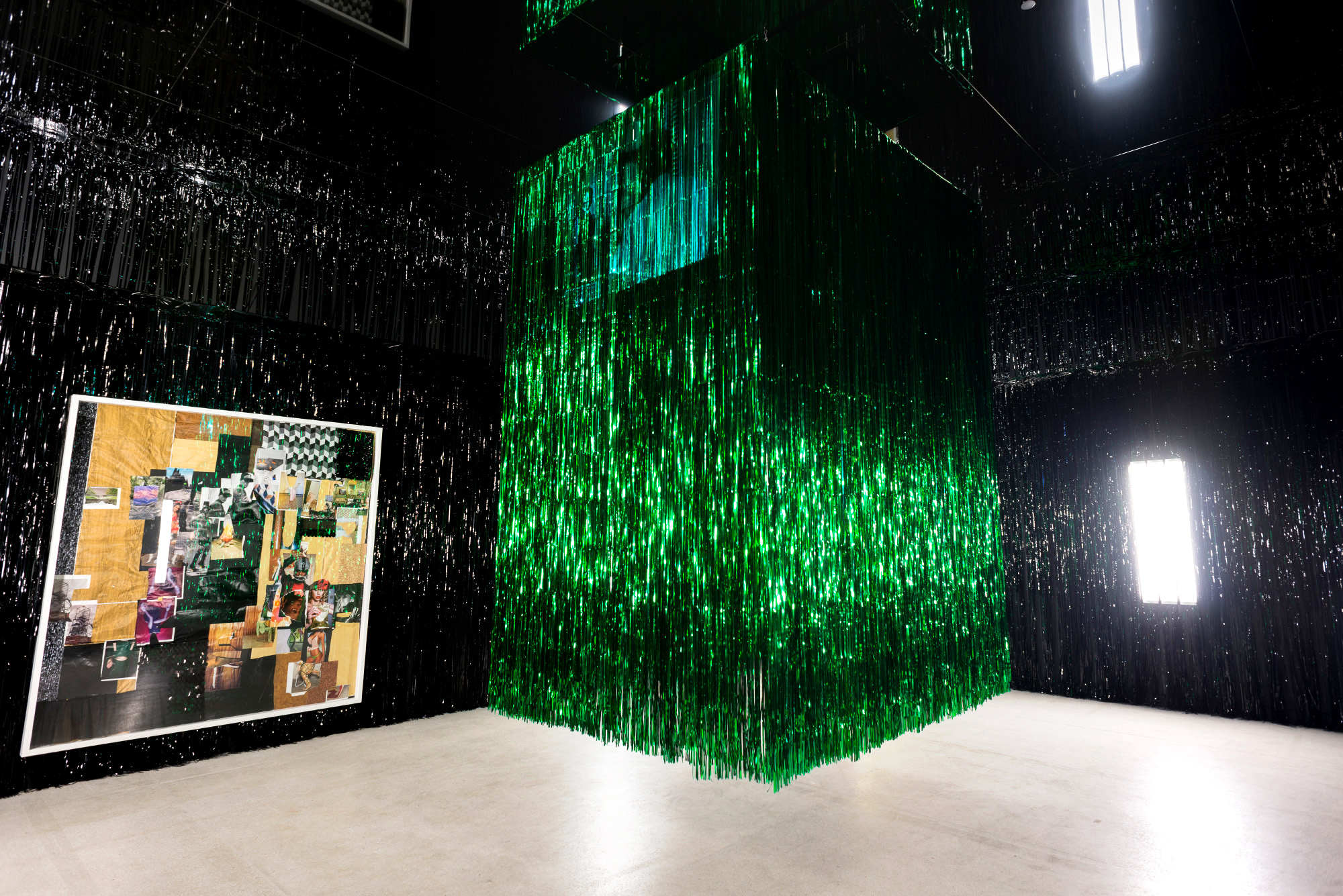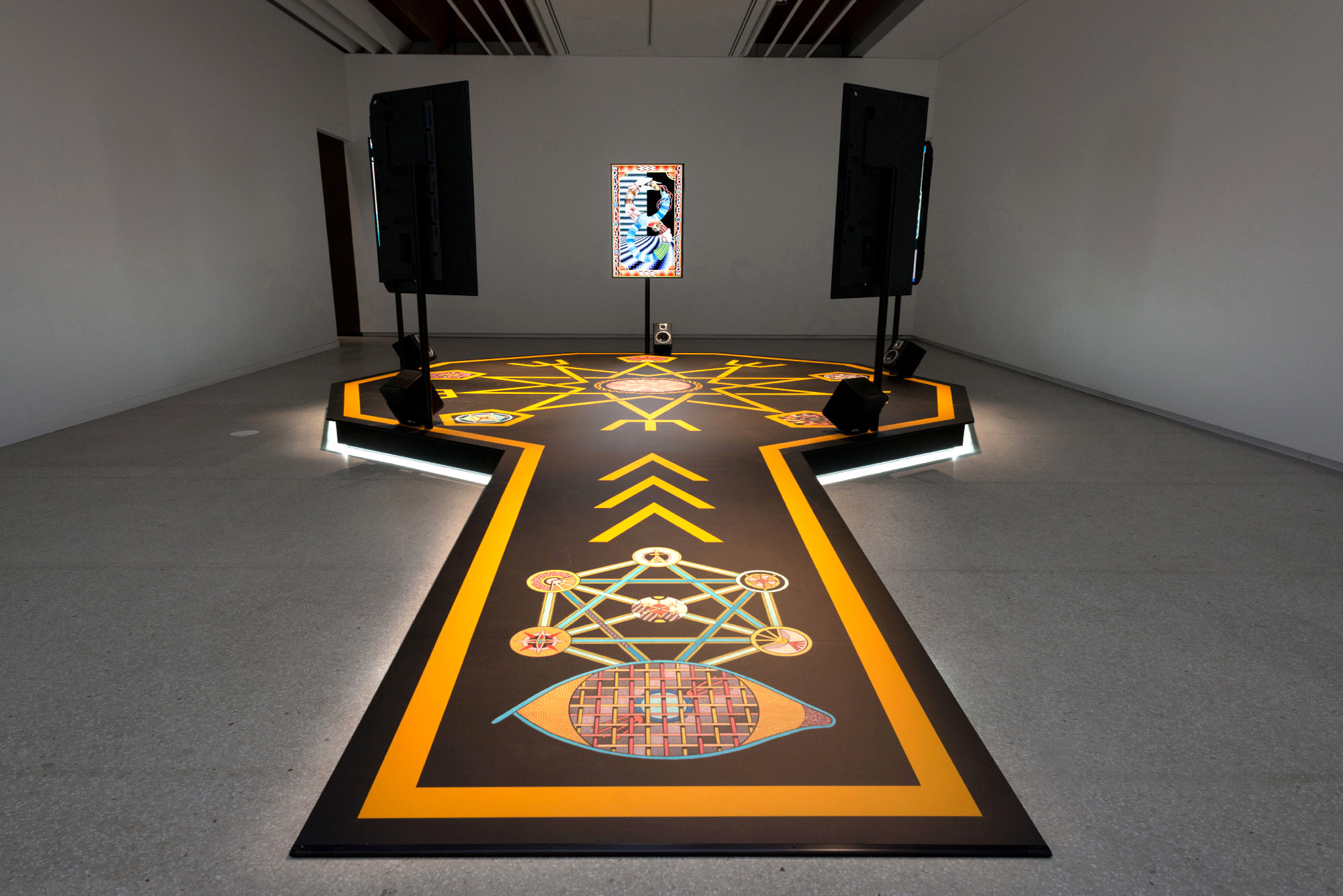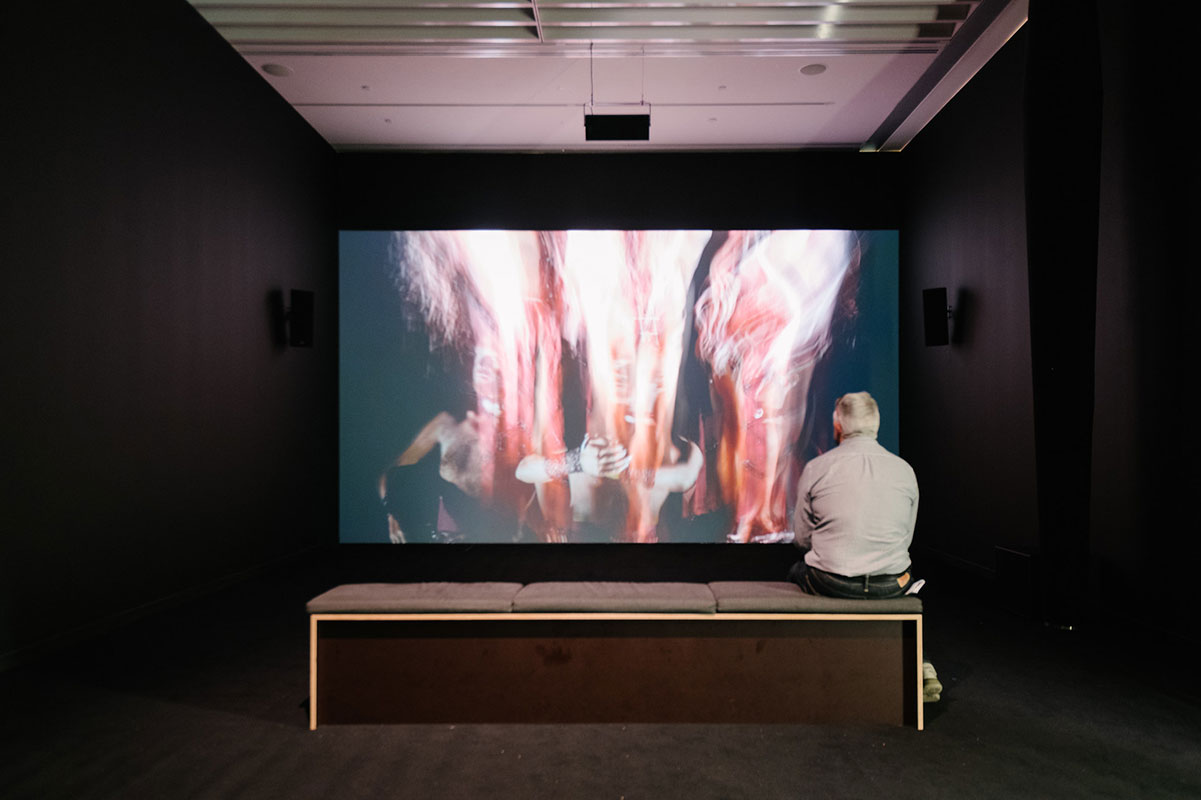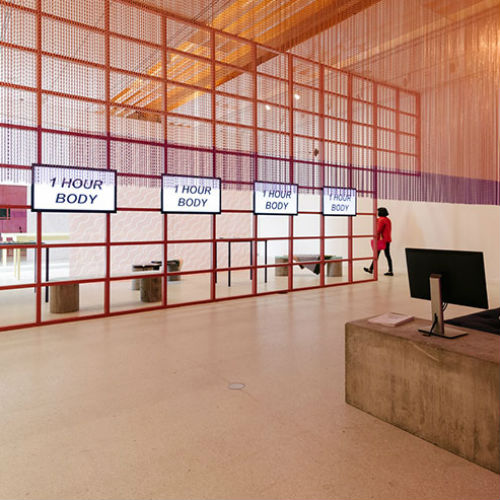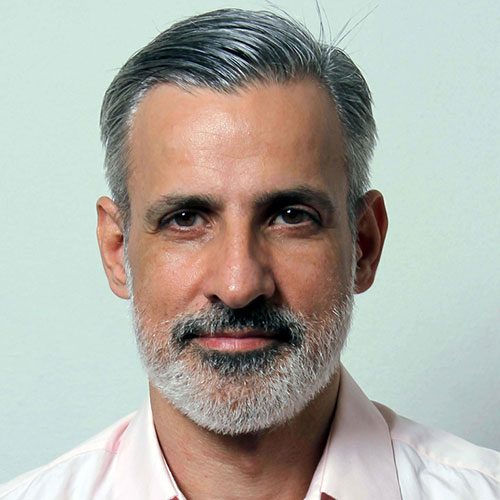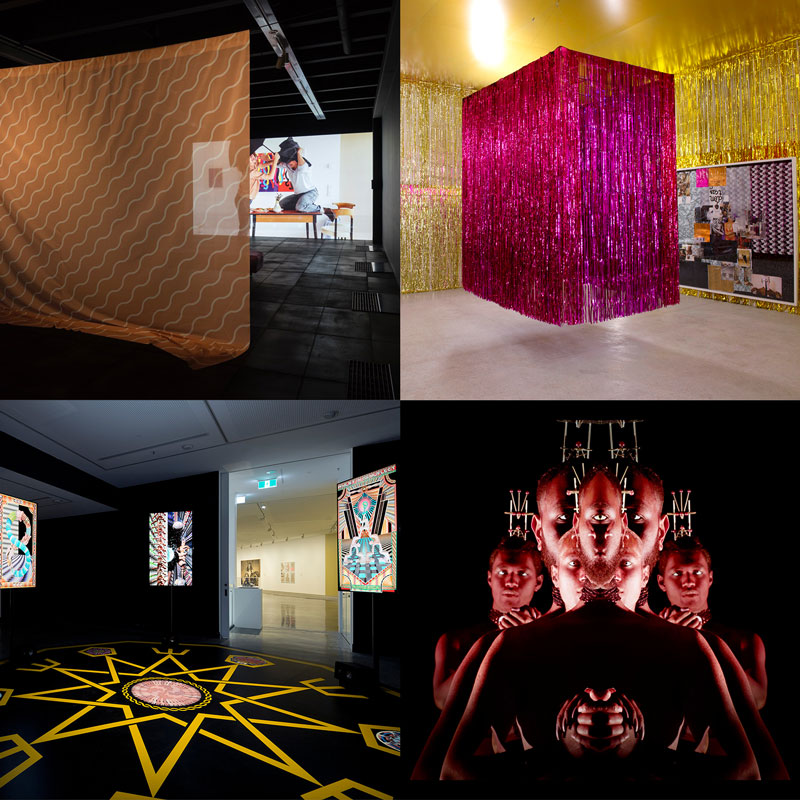New Zealand's contemporary art award, the Walters Prize returns to the Gallery in 2018 for its ninth iteration.
Named in honour of pioneering modernist painter Gordon Walters (1919–1995), the Walters Prize is awarded for an outstanding work of contemporary New Zealand art produced and exhibited during the past two years. The biennial Prize aims to make contemporary art a more widely recognised and debated feature of cultural life.
Previous winners were; Yvonne Todd for Asthma and Eczema (2002), et al. for restricted access (2004), Francis Upritchard for Doomed, Doomed, All Doomed (2006), Peter Robinson for ACK (2008), Dan Arps for Explaining Things (2010), Kate Newby for Crawl out your window (2012), Luke Willis Thompson for Inthisholeonthisislandwhereiam (2014) and Shannon Te Ao for Two shoots that stretch far out 2013–14 and Okea ururoatia (never say die) 2016 (2016).
Winner
The Walters Prize 2018 was awarded to Ruth Buchanan for her presentation of BAD VISUAL SYSTEMS 2016/2018. The winner was announced by international judge Adriano Pedrosa at an awards dinner on Friday 2 November 2018.
Finalists
Nominated for:
BAD VISUAL SYSTEMS, solo exhibition that included work by Judith Hopf and Marianne Wex upon invitation of the artist, Adam Art Gallery Te Pātaka Toi, Victoria University of Wellington, 2 October – 22 December 2016
Jury statement:
In the exhibition BAD VISUAL SYSTEMS, Ruth Buchanan provocatively blurred the roles of artist, designer and curator. Her complex installation incorporated text, video, sound and a variety of large-scale sculptural features in order to fundamentally alter the way the site was navigated and how artworks were encountered. A series of motion-activated speakers served as audio-guides for the exhibition coming to life as audience members moved towards them, videos were experienced alongside gallery hosts, and room dividers rearranged familiar spaces, disrupting existing way-finding and skewing the perception of historical features of the building. Buchanan strategically included key artworks by fellow artists Marianne Wex and Judith Hopf, weaving these into the fabric of the exhibition through her unconventional display systems. Their presence in the show further positioned her thinking within a lineage of feminist discourse that values collegiality over the individualist aspirations of a solo exhibition. The exhibition represented an extraordinary achievement in Buchanan’s constantly expanding practice.
Nominated for:
The Making of Mississippi Grind 2017, 2017, mixed-media installation, Auckland Art Gallery Toi o Tāmaki, 20 May – 15 October 2017
Jury statement:
The Making of Mississippi Grind 2017 operates as a sponge for an array of popular cultural references, casting a seductive gaze towards celebrity, rap culture and high-fashion. The installation exemplifies Jacqueline Fraser’s ability to create viscerally charged domains at an architectural scale; complete with a gold ceiling reflecting pink and gold tinsel from the walls and chandelier, and pumping sound tracks including Rhianna and Migos. The light from the film ‘Mississippi Grind’ was projected across the space, its soundtrack muffled every five minutes by one of the 19 rap songs.
As well as large-scale, site-specific installations, Fraser’s THE MAKING OF series includes thousands of individual collages, three significant examples of which featured in the exhibition. Each collage in the series references a film, from mainstream Hollywood movies to cult classics. But in titling her works as fictional ‘making of’ documentaries, Fraser’s intention is less to represent these films than to position her own collages and installations as short-form documentary mash-ups: instigating an irreverent procedure of exhibition making that uses the content from the films as a prompt to lay bare the production of image culture.
Nominated for:
Whol Why Wurld, 2017, mixed-media installation, raised decagon platform, floor painting, vinyl decals, 5 x looped videos, Carriageworks, Sydney, 30 March – 25 June 2017.
Jury statement:
Jess Johnson’s five-channel video installation Whol Why Wurld, made with Simon Ward, expands her drawing practice into digital and architectural space. Johnson’s distinctive drawings collect together rich tapestries of imagery drawn from a plethora of sources, including cosmic mythology, science fiction, early video games, RPG modules, architecture of the middle ages and traditional quilt-making. Optically complex and unsettling, Whol Why Wurld creates a collision between Johnson’s manually produced paintings and cutting-edge moving image technology.
Whol Why Wurld builds on an active collaboration, where over the past five years Johnson has worked with Wellington-based animator Simon Ward in order to digitise her drawings and create dynamic computer-generated worlds. Grounded in a shared interest in retro aesthetics, these complex HD video installations occur within a speculative space, complete with sound by Andrew Clarke and computer graphics by Luke Rowell.
Nominated for:
Fāgogo, 2016, single-channel HD video, ST PAUL St Gallery, AUT, Auckland, 8 June – 21 July 2017
Jury statement:
'Fāgogo’ is a traditional practice that involves theatrical and performance-based forms of storytelling, which take place at night, before sleep. Pati Solomona Tyrell’s video work Fāgogo, likewise, explores this border between sleeping and waking. Individual figures merge into trios of fragmented bodies which continually mirror and fold into one another, conveying fluid gender and sexual identities. The powerful rhythmic texture of the video sustains this sense of bodies undergoing transformation in time, and in tune with a natural world which shuns the singular or, to quote, Tyrell: ‘I am not an individual’. Instead bodies are kaleidoscopic, iridescent and shape-shifting; figures move in liquid rhythms. At once intense and gently dreamlike, the work creates passages between the disparate notions of sea and land, ancient imagery and new media.
Alongside Fāgogo, the exhibition hosted performances, research and events associated with the collective FAFSWAG, of which Tyrell is a founding member and principal photographer.
Jury statement
‘In selecting this years’ nominees, we tabled over 30 projects by New Zealand practitioners, realised both within New Zealand and offshore. The selection represents our genuine attempt to work across multiple fronts within a continually shifting contemporary art scene – by consolidating and considering practitioners who have, within their distinctive artistic practices, made outstanding contributions to the contemporary art field.’
‘Our selection includes work that expands ideas of sex, gender and ritual; installations exploring the legacies of feminism; and an immersive work that embraces and pushes technologies of moving image and animation.’
International Judge
The international judge for the Walters Prize 2018 is Adriano Pedrosa, Artistic Director at the globally renowned São Paulo Museum of Art (MASP), Brazil. Pedrosa is an eminent Latin American writer and critic and internationally recognised for his curatorial work across significant biennial platforms, including São Paulo, San Diego/Tijuana (inSite) and Istanbul.
Judge's statement
'Ruth Buchanan’s BAD VISUAL SYSTEMS, 2016/2018 at Auckland Art Gallery unfolds an original installation of the same title presented at the Adam Art Gallery in Wellington in 2016. In the work, Buchanan articulates in a complex and precise manner several components and media – sculpture, textiles, furniture, decoration, architecture, performance, sound, graphic design, text, poetry, publications, the exhibition format itself (hers and others around the Gallery), constructing an environment through which the viewer/visitor may navigate and may feel as an integral part. Furthermore, Buchanan draws on the work of other artists – from her own colleagues Mariannne Wex and Judith Hopf, to artists Rachel Whiteread and the Women’s Art Archive, whose works are exhibited at the Gallery.
The many layers, materials, media, textures, surfaces and voices in the installation provides a distinct polyphonic quality to the exhibition, at times in fact poetically verging on the cacophonic, as in the case of the artist’s own voice which reads several of her writings penned in the course of many years. Although there are intricate formal plays in many different levels in a truly expanded field (from sculpture to architecture, from painting to design, from performance to audio component, from manifesto to poetry), there is also a concern with issues around politics, power, feminism and the body, all arranged in processual, open, speculative ways, that take into account competing, overlapping, contradictory modes of representation, both visual and verbal, aural and spatial – a tour de force on language itself, one could say, yet not so much framed as an efficient means of communication, but as a fantasy of “bad visual systems...”.'
Extras
News
Shop
FAQs
Every two years Auckland Art Gallery Toi o Tāmaki presents an exhibition by four artists who have been nominated for their outstanding contribution to contemporary art in New Zealand. The Walters Prize is unique because it focuses on an outstanding artwork or body of work made within a two-year period, as opposed to an artist’s entire practice. The prize is named after New Zealand artist Gordon Walters (1919–1995), the subject of a timely retrospective at the Gallery this year. Walters, a leading modernist, produced abstract art of remarkable refinement and stimulated an ongoing discussion about the interrelationships between European, Māori and Pacific visual art traditions.
The prize, established in 2002, was the initiative of Founding Benefactors and Principal Donors Erika and Robin Congreve and Dame Jenny Gibbs, working in partnership with Auckland Art Gallery. Our shared belief is in helping to increase access to and grow understanding of contemporary New Zealand art.
The Gallery establishes an external jury two years prior to the exhibition. This consists of four art professionals from outside Auckland Art Gallery whose job it is to determine which artworks exhibited over the two-year period contribute to enhancing art practice and the understanding of contemporary art in New Zealand. Regardless of an artist’s age, ethnicity or location, their work needs to have exerted a remarkable impact or influence on the nature, perception or development of contemporary art in this country.
This year the jury members were:
- Stephen Cleland, Curator, Adam Art Gallery Te Pātaka Toi
- Allan Smith, freelance curator and Senior Lecturer, Elam School of Fine Arts, University of Auckland
- Lara Strongman, Senior Curator, Christchurch Art Gallery Te Puna o Waiwhetū
- Megan Tamati-Quennell, Curator Modern & Contemporary Māori and Indigenous Art, Museum of New Zealand Te Papa Tongarewa
To determine the Walters Prize winner from the four nominated artists, an international judge is invited to New Zealand to view the artworks presented here and assess their merits. The judge is an art professional with the highest of international reputations, and must be a leading figure in the curation of contemporary art.
This year’s judge is Adriano Pedrosa, Artistic Director at the globally renowned São Paulo Museum of Art (MASP), Brazil. Pedrosa will announce the winner at an awards dinner on Friday 2 November.
Previous judges have included: Harald Szeemann (2002), Robert Storr (2004), Carolyn Christov-Bakargiev (2006), Catherine David (2008), Vicente Todolí (2010), Mami Takaoka (2012), Charles Esche (2014) and Doryun Chong (2016).
Each year the artworks selected pose a new answer to the question, What is important or relevant in contemporary New Zealand art today? This year, while there is no single theme that unites the artists and their content, they all produce installations which are highly immersive, pushing technology and our exhibition spaces into new directions through video, sound, architecture or content itself. Three of the four installations invite audiences to reflect on questions of gender and ethnicity, and all reach for art’s ongoing potential in a year of heightened global unrest.
A change to the Walters Prize rules in 2013 means that artists are now given the opportunity to exhibit either their nominated artwork or a new work. This year the artists variously offer an alternative version of their nominated work, an extension or translation of the original into the new architectural site. Additionally, while we have three artists new to the Walters Prize family, we welcome back renowned New Zealand installation artist Jacqueline Fraser, who was a finalist in the second Walters Prize exhibition. It is testimony to the process and rigour of New Zealand art and its support systems that many outstanding New Zealand artists have now contributed to this family of exhibitions.
